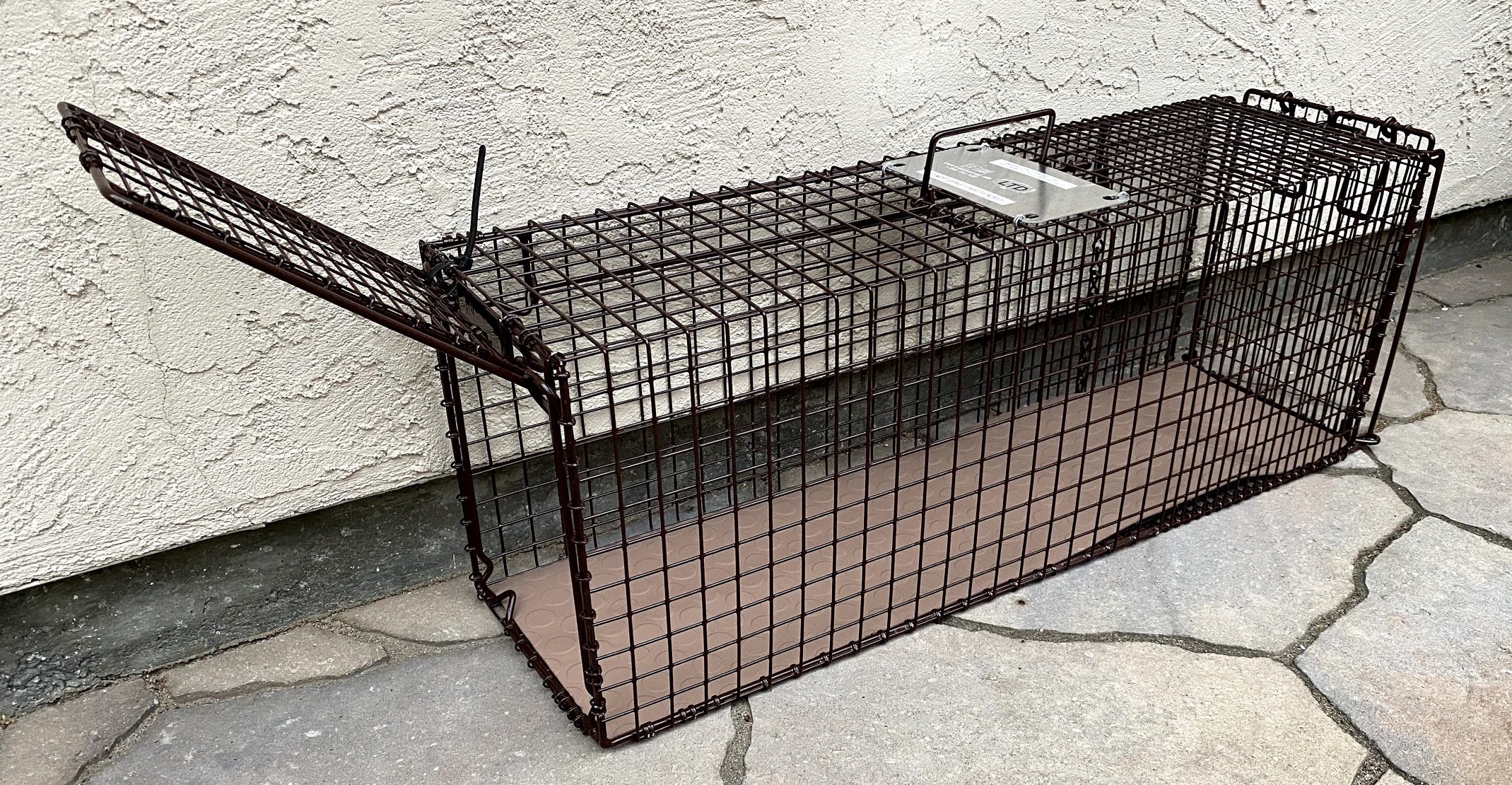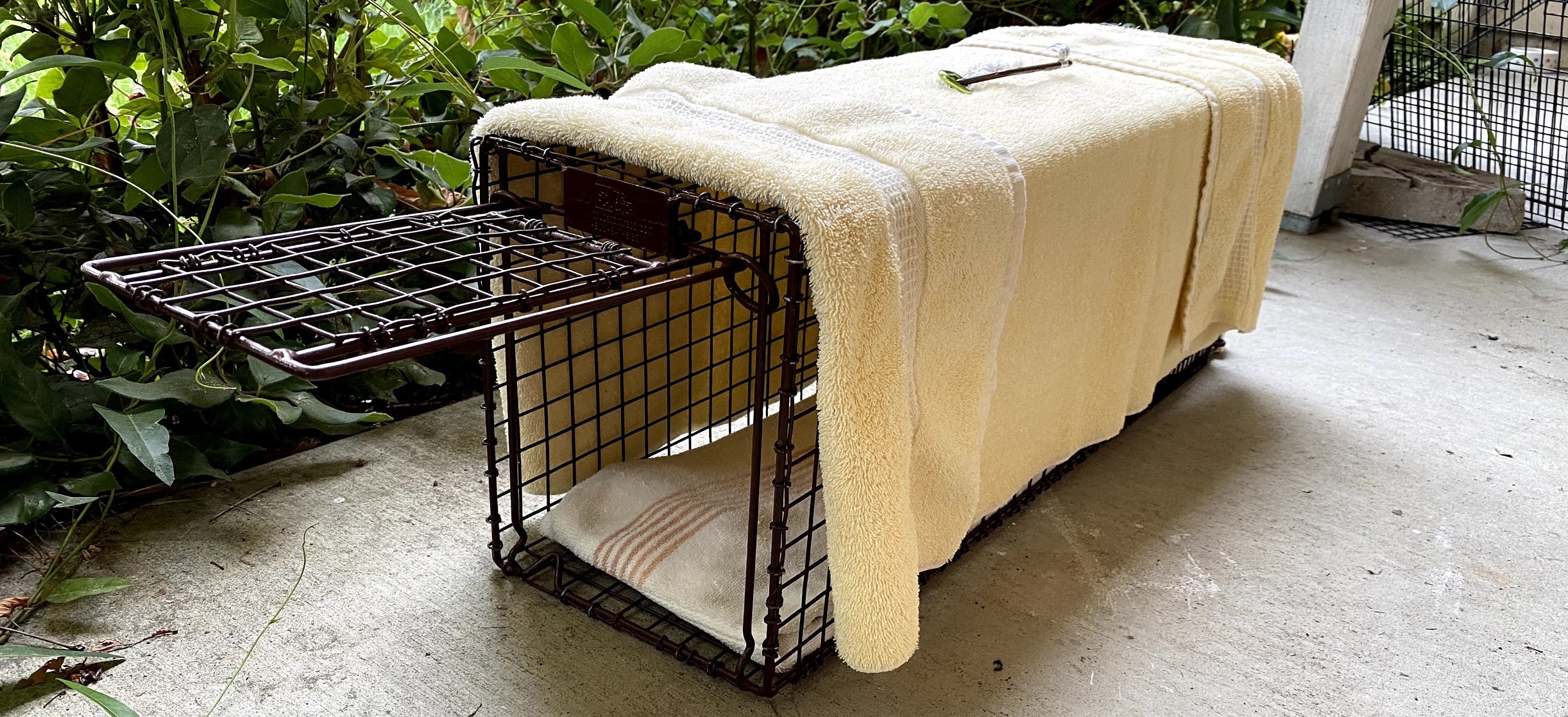Trapping
Appointments • Trap rentals • Setting traps • Recommended traps • Hard to trap cats
Getting Started
- Find a place for TNR. It can take several weeks to get a TNR appointment, so do this as soon as possible. Check the TNR list below and follow the steps based on the cats location. Join bit.ly/bayareacats for support and advice on the best way to get appointments.
- Borrow a trap. Check out Trap Rentals or contact us for more suggestions. Trap train while waiting for your appointment, zip tie open the trap so it doesn't trap a cat, and start feeding the cat inside of the trap. This will get the cats familiar with the trap.
- Learn to trap. Read over the Trapping page for tips, and follow the steps below:
- Read over our trapping guide: bayareacats.org/guide
- Watch some trapping videos. The kitten lady offers a good trapping overview.
- Take a TNR course offered by Neighborhood Cats.
- Trap the cats. Withold food 12-36 hours before trapping. Only trap the cats the night before your appointmnet.
Not enough or feeling overwhelmed? Contact us at info@bayareacats.org.
TNR Appointments
| Shelter | City cat found in | Intake & TNR |
|---|---|---|
| San Jose Animal Care Center 2750 Monterey Hwy San Jose, CA 95111 408-794-7297 |
San Jose Cupertino Milpitas Saratoga Alviso |
Intake: Pregnant, sick, or injured cats can be dropped off 10-5pm, 7 days a week. Kittens or friendly cats IN TRAPS may be accepted if there is capacity. TNR: For TNR appointments, submit this form and wait to be contacted. |
| Silicon Valley Animal Control Authority 3370 Thomas Rd Santa Clara, CA 95014 408-764-0344 |
Campbell Monte Sereno Santa Clara Mountain View Los Gatos |
Intake: Sick or injured cats are accepted without appointment, but call ahead. Friendly cats are only accepted if sick, injured, or pregnant. TNR: Use the Community Cat Spay and Neuter Form to request spay and neuter services. Learn more about their Community Cat program here. |
| Santa Clara County Animal Services 12425 Monterey Road San Martin, CA 95046 408-686-3900 | Gilroy Morgan Hill NEW! Sunnyvale Unincorporated areas of Santa Clara County |
Intake: Injured or very sick feral or stray cats and kittens may be taken to the shelter between noon and closing time (6 PM on weekdays, 5 PM on weekends). TNR: TNR surgeries are on Tuesday and Thursday. Drop off is 8am and pick up is the same day 2:30-4pm. Appointments are first come first serve. Limit of one cat per person per day, and no two cats can come from the same address on the same day. The person dropping off must reside in their jurisdiction. |
| Pets In Need 3281 E Bayshore Road Palo Alto, CA 94303 650-496-5971 | Palo Alto Los Altos Los Altos Hills |
TNR: Email pa-medical@petsinneed.org to schedule an appointment for TNR. They have a feral cat package for $50 per cat which includes spay/neuter, rabies, and microchip. |
| Peninsula Humane Society 12 Airport Blvd San Mateo, CA 94401 650-340-7022 x679 |
San Mateo County | TNR: Peninsula Humane Society has a street cat package for $50/cat (vaccines, FIV/FeLV test, spay/neuter, microchip). Limited to residents in San Mateo County. |
Renting traps
Bay Area Cats lends traps in Sunnyvale using this form. Both SVACA in Santa Clara and SJACC in San Jose have a trap rental program for cats in their jurisdiction. For SVACA, call dispatch to inquire about trap rentals. For SJACC, walk into the main lobby to ask.
- The Dancing Cat • info@thedancingcat.org
- 13th Street Cat Rescue • 408-566-3637 • tnr@13thstcats.org
- Cat Resource Center • (408) 335-4357 • admin@catcenter.org
Flyers & Guides
Request help
Submit a TNR RequestUse this form to submit a TNR request for Sunnyvale cats. Provide as much detail as possible, and get the contact information of the person feeding the cats before submitting the form.
Preparing to trap
Here are several tips that will make trapping easier. A good place to begin is to review the Getting Started guide.
- Community outreach. Talk with the neighbors in the area you are trapping, hand out flyers, and educate them about trap-neuter-return (TNR). Find out who feeds the cats, and get their contact information to coordinate withholding food.
- Count the cats. Get a count on the number of untipped cats by asking neighbors and seeing who visits.
- Withhold food. Remove all food sources 24-36 hours before trapping. This ensures cats are hungry enough to enter traps.
- Trap training. If you have access to traps but are waiting for your appointment, zip tie open the trap (so it won't catch a cat) and feed the cats only inside of the trap for several days before trapping. When cats see other cats get trapped, they start getting trap smart, and trap feeding ahead of time makes it a lot easier to trap the last few cats.

Setting traps
Here is a guide from Alley Cats about TNR. Take a look at the Getting started section on the Resources page for trapping tips.
- Base: use newspaper, cardboard, pee pads, vinyl flooring. I find the vinyl flooring the best and easiest to clean.
- Bait: tuna, sardines, Fancy Feast flaked fish & shrimp, and Friskies are all good options. Only use a small amount at the very front of the trap (2-3 very small piles) leading towards the trip. The main bait (1 Tbsp) is placed at the very back of the trap behind the trigger plate. Note: do not put any bait on or near the trip plate, or it will cause an early trigger and the cat can escape.
- Placement: place the trap flush against a wall, plants, or other objects. The best spot for the trap is where they are used to eating.
- Cover: I like to trap uncovered with close supervision of traps. If the trap is uncovered, you must be able to immediately cover the trap. If you are not able to get to the trap within 30 seconds, the trap MUST be covered during trapping.
Recommended Traps
The Tomahawk Gravity trap is a high quality trap with a gravity door. This is similar to a Tru Catch, but has a locking mechanism for the front door. For large tomcats or single cats, Tomahawk FixNation 32" with powder coating is a good option.

Tru Catch
Tru catch traps are quiet and have a backdoor for feeding and transferring to clean cages. They work for kittens and adults.

Drop traps
Drop traps are generally used for hard to catch cats or previously caught cats. Learn to use a drop trap.
Hard to trap cats
All cats can be trapped, don't give up! Try the techniques below if you encounter a difficult cat. First, ensure you are following the steps in the Setting traps section, including using good bait, placement of thet trap, and using something on the floor of the trap.
- Trap train. Zip tie open the trap (so it won't shut), leaving food in the trap, and see if the cat goes in overnight. You may need to remove or open the back door of the trap so the cat feels more comfortable. If needed, start with the food outside of the trap, and slowly move it to the back over several days.
- Communicate with your neighbors. If you feed cats, so do your neighbors. Knock on doors, look for signs of bowls, post on Nextdoor, and hand out flyers. Coordinate trapping so everyone withholds food at the same time. Leave notes (repeatedly) by the food bowls.
- Withhold food. Do not feed after trapping! Withhold food and try again the next day if you are not successful. You may need to withhold food 24-48 hours to get the cat to go in the trap.
- Use catnip. Try catnip at the back of the trap, or under the drop trap.
- Keep your distance. Don't stand near the trap. Wait in your car or house with the window cracked to listen for the trap.
- Use a bait trail. Add a bait trail from the front to the back of the trap. Also put a tiny dab of food outside of the trap.
- Be patient. You may need to wait 3-4 hours for the cat to go in the trap.
- Get a camera. Watch if the cat is going in the trap at night, how close they are getting to the trap, and what hours they are around most. Wyze V3 is affordable and high quality (requires WiFi / plug).
- Try a drop trap. Ask on Nextdoor or contact 13th St Cats (info@13thstcats.org) or The Dancing Cat (info@thedancingcat.org) to borrow a drop trap.
- Bottle and string. If you keep trapping fixed cats, try the bottle and string method. Attach a half filled water bottle to a string. Prop open the trap door with the bottle. Wait until the target cat is eating in the trap, and pull the string quickly to remove the bottle, shutting the door. You’ll want to use enough food in the trap so the fixed cats can eat and leave.
Still not working? Try these tips below.

